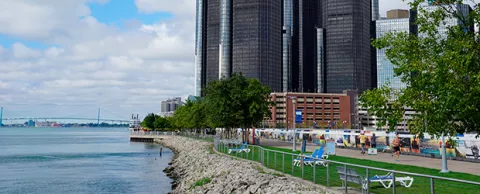
When budgets are tight, you might think it would be impossible to find a way to bring a large open space project to life. But Detroit is well on its way to turning 13,000 acres of open space into a paradise with new recreation opportunities, farms, green stormwater infrastructure and nature reserves.
The key to the project was an innovative approach to financing. As you’ll read below, it carefully evaluated dozens of funding sources — many never tapped before — to build a feasible plan. It’s worth studying Detroit’s approach to unlock the potential in your city. — Jesse Berst
By Mike Matichich and Mark Mittag, CH2M
The Detroit Future City Strategic Framework is an ambitious initiative aimed at creating vibrant, open spaces and thriving neighborhoods throughout the city of Detroit. Its vision and recommended actions are intended to guide decision making by all of the stakeholders in Detroit.
Detroit Future City Implementation Office commissioned the Center for Community Progress (CCP) to identifying creative funding strategies to support the Strategic Framework development and implementation. CH2M was invited to join CCP’s team, and worked closely with CCP and the Natural Resources Defense Council (NRDC) to support this exciting effort.
By combining some of the industry’s most advanced analysis tools with a collaborative funding identification process, the resulting funding study evaluated more than 45 funding sources — many of them previously untapped — to help implement the Strategic Framework’s vision into a future reality.
Primary sources for identifying these funding opportunities came from the Smart City Council’s Smart Cities Financing Guide and the Infrastructure Financing Options for Transit-Oriented Development, which CH2M developed as part of EPA’s Smart Growth Program in 2013.
As part of this comprehensive study, we assessed the applicability of dozens of funding strategies against eight priority land use options, including:
- Productive landscape including urban farms, solar, biofuel and tree farms
- Green stormwater infrastructure
- Natural land use including meadows and forests
- Public open space for parks and recreation
We thengrouped the most feasible funding opportunities — traditional to emerging — into six primary categories:
1. Direct fees including user fees and general funds
2. Debt tools including industrial revenue and green infrastructure bonds
3. Credit assistance tools including federal loan guarantees
4. Private sources including public-private partnerships and social impact funds
5. Value capture mechanisms including special improvement districts and tax increment financing
6. Grant funding including state, federal and institutional options
As a result of this CCP-led work, Detroit Future City, city agencies, developers and other stakeholders now have a range of funding options for the envisioned 13,000 acres of open space in Detroit.
For cities seeking creative funding solutions for implementing smart technologies, this study provides a powerful model for mapping available funding sources to priority development needs and capital investments. (View the full matrix of funding options in CCP’s report Open Space in Detroit.)
Mike Matichich serves as the firm wide Practice Area Lead for Financial Services consulting at CH2M. He has more than 30 years of experience in helping clients develop and implement financing and funding strategies for their infrastructure development programs. Mark Mittag managed CH2M’s role for the Open Space in Detroit report. He evaluated the technical options for repurposing open space for green stormwater infrastructure and natural landscapes.



